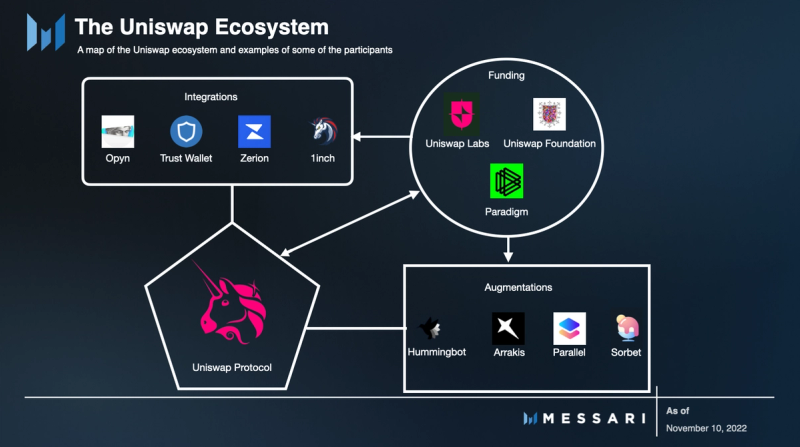Key Insights
- To continue on its current growth trajectory, Uniswap will have to find ways to expand its total addressable market.
- Uniswap has successfully launched deployments on Layer-2 scaling solutions, accounting for 65% of all Layer-2 DEX volume in Q3 2022.
- A number of projects have taken advantage of Uniswap’s software development kit, either integrating the Uniswap protocol or augmenting its functionality.
- Whether or not to turn on the fee switch is a big debate for Uniswap’s growth. The question is whether a new capital pool for growth investments would offset a weaker competitive position with liquidity providers.
Uniswap has found product-market fit. The release of Uniswap V3 addressed the automated market maker’s most glaring flaw — capital inefficiency. On the other side of the equation, Uniswap has successfully saturated its current addressable market: it’s the largest decentralized exchange (DEX), with a cumulative $1.3 trillion in trading volume and more than 70% of Ethereum’s DEX volume.
The dilemma is that this dominant position has come about precisely because Uniswap has successfully eaten the low-hanging fruit. This means continuing to optimize the DEX and squeeze growth in existing markets won’t be sufficient to continue on its current trajectory.
However, Uniswap has kept to its ethos of innovation and approachability, and begun to pull the most challenging lever of growth: expanding its total addressable market. In other words, appealing to a wider audience. In the past, Uniswap has expanded its market using fairly straightforward methods, such as Layer-2 (L2) deployments. But it’s also employed more complex strategies, such as developing a robust ecosystem around funding, supplementary projects, and integrations. As a centerpiece of crypto’s value flows more broadly, the outcome of initiatives like the NFT integration and the fee switch will have wide implications for the entire space.
Multichain
Uniswap Labs launched the flagship V1 AMM on the Ethereum Mainnet in November 2018 and V2 in 2020. The launch of V3 in 2021 addressed capital efficiency issues and marked the beginning of the protocol’s expansion into a multichain future.

In addition to Ethereum Mainnet, Uniswap V3 was subsequently deployed to EVM-scaling solutions Optimism, Arbitrum, Polygon, and Celo. These deployments swiftly attracted liquidity and volume from other DEXs. Liquidity supplied across these deployments climbed as high as $246 million, and more than 65% of all DEX volume on these chains flowed through Uniswap in Q3 2022. Volume on Uniswap’s Layer-2 deployments now accounts for almost 20% of the protocol’s total volume.
As more EVM-scaling solutions are developed, there will likely be additional proposals advocating for Uniswap deployments on other chains. In October, a proposal was executed to deploy Uniswap V3 on zkSync 2.0 and is expected to go live in Q4. Additionally, in a “Temperature Check” on Snapshot, token holders signaled in favor of deploying V3 on Aurora. If the proposal passes, Aurora outlined plans to incentivize Uniswap users with $5 million split between funding a liquidity mining campaign and long-term protocol development.
Multichain and Ethereum Layer-2 deployments come with minimal costs. In fact, they’re oftentimes incentivized by chains offering their native token to Uniswap users. Additionally, these chains have smaller gas fees than Ethereum, effectively lowering the barrier to entry for smaller investors and expanding Uniswap’s user base. Given Uniswap’s proven reputation and deep liquidity, newer chains tend to implement incentivization strategies in the hopes that users and their liquidity will stick around in the long term.
Funding
Uniswap Labs recently raised $165 million in a Series B round led by Polychain Capital. The funds will be used to expand the development of Uniswap’s product line to reach a wider range of users.
In addition to the capital injection, Uniswap’s vision is backed by a massive community treasury of more than $1.7 billion of UNI at time of writing. Tokenholders are responsible for determining how the treasury is used, funding internal organizations such as the Uniswap Grants Program (UGP) and more recently the Uniswap Foundation (UF).
Upon creation, UF absorbed and expanded UGP with an allocation of $60 million of UNI over the next three years. In the nearly two years since the UGP launched, ~$9 million in grant funding has been awarded to a range of ecosystem initiatives. The number of projects building on top of Uniswap will likely increase with a renewed grant budget aimed toward expanding Uniswap’s ecosystem.
Outside of grant funding, the UF has supported several community-led projects — most notably, the ongoing liquidity mining (LM) program on Optimism. Instead of directly launching an LM program, UF is deploying 800,000 OP received from the Optimism airdrop through community partners including Arrakis Finance, xToken Terminal, and Gamma Strategies.
These projects offer active liquidity management services for Uniswap V3 pools, thereby supporting an efficient distribution of incentives to users providing “in-the-money” liquidity and resulting in deeper pools. At the same time, some users are familiar with swapping tokens, but they refrain from providing liquidity due to misunderstanding the flexible mechanics of Uniswap V3 or needing active management to maximize returns. When new and existing projects use these projects for distribution, they are exposed to LP tools that provide relief for known deterrents.
Supplementary Projects/Ecosystem
While traders and liquidity providers are the two obvious sets of users, a third, oft-overlooked group is developers. Since Uniswap is open source, all builders can apply their ingenuity to and with Uniswap using the Uniswap software development kit (SDK). In practice, this means projects integrate Uniswap or augment the existing platform.
By having projects integrate its DEX, Uniswap benefits from the usage driven by many of the latest DeFi innovations and experiments without any additional leg work. Moreover, when developers augment Uniswap’s functionality, they attract a wider cohort of users to the DEX. Most of these projects either simplify the user experience or add more sophisticated ways to interact with the protocol, all without bloating the core user interface.

Integrations
New project integrations can be broadly placed in three buckets: aggregators, wallets, and other DeFi protocols.
In terms of user growth and acquisition for Uniswap, aggregators are probably the least impactful category. DEX aggregators in particular, such as 1inch and ParaSwap, exist purely to optimize execution (price including slippage, fees, and gas costs). While aggregators have brought in 26.8% of Uniswap’s volume over the last two years, they only route 48.6% of their volume through Uniswap. And even though aggregators are a useful utility, they don’t attract additional volume since they have no built-in growth flywheel or network effects of their own (i.e., for DEXs, trading volume increases liquidity and vice-versa).
The other cohort within aggregators is dashboards. These non-custodial interfaces, such as Zerion, Zapper, and Instadapp, make Uniswap easier to use. They simplify the user experience by displaying position data and enabling position management all in one place. Position management allows users to create new positions (swaps) and liquidity provision, both of which tap into Uniswap.
Another group of projects tapping into swap functionality is wallets. Wallets such as Trust Wallet and Rainbow Wallet have integrated the Uniswap protocol, meaning users can execute swaps directly in their wallets. Other popular wallets, such as the Coinbase Wallet, also offer swaps through DEX aggregators (i.e., 0x), which often end up routing through Uniswap.
Other DeFi protocols integrate Uniswap in a number of different ways. Simpler integrations, through protocols such as Para Space and MakerDAO, offer LPs greater capital efficiency by enabling them to use their V3 liquidity positions as collateral. Projects such as Opyn and Ondo Finance have used Uniswap integrations to automate more sophisticated strategies for users in their options and structured product offerings, respectively.
Augmentations
Uniswap’s augmentations can broadly be seen as ways to simultaneously expand functionality and make the protocol easier to use.
On the liquidity provision end, projects like Arrakis Finance automate liquidity management on Uniswap V3 and reintroduce composable LP tokens. Arrakis Finance in particular currently manages about $880 million of liquidity on Uniswap V3, or roughly 31% of its total liquidity. On the swap side, traders can use projects like Sorbet Finance to set limit orders.
Other projects expand Uniswap’s non-human market. As of this writing, trading bots are projected to make up anywhere from 20-40% of Uniswap’s trading volume. Open-source software like Hummingbot helps users create high-frequency bots that run market making and arbitrage strategies with Uniswap.
NFTs
While Uniswap already uses NFTs to represent V3 liquidity positions, this is quite different from the NFT integration in its roadmap, which will bring NFT swaps to the platform. Uniswap Labs’ June 2022 NFT announcement was centered around the acquisition of NFT exchange aggregator Genie. Since then, Scott Gray, the founder of Genie, and now Uniswap Labs’ NFT product lead, has continued to color in the Uniswap NFT roadmap.
The Genie acquisition and sudoswap integration announcements point to Uniswap’s decision to aggregate and source liquidity from multiple NFT exchanges rather than “owning” the liquidity like it does for ERC-20 tokens. Tactically this makes sense, since token marketplaces rely more on depth (reducing slippage) while NFT marketplaces rely on breadth (variety).
In terms of user growth and acquisition, this strategy could have far-reaching implications since NFTs currently have a significantly larger total addressable user base than token trading. All said and done, the initiative will bring a new and larger user base over to the DEX while cutting customer acquisition costs.
Risks
The open-source nature of Uniswap has fostered user growth and ingenuity by allowing community developers to build on top of the protocol. Although these additional layers often abstract the customer away from the core AMM, they can introduce risk associated with not owning the customer relationship.
For example, augmentations that simplify investment strategies require users to interact with smart contracts that were not developed by the Uniswap Labs team. In the event of a smart contract exploit, user funds may be lost at no fault of Uniswap, but still have a negative effect on user confidence and the Uniswap brand. Additionally, fragmentation at the point of interaction decreases visibility of the Uniswap brand and transfers attention to overlaying projects that have no guarantee of remaining loyal to the Uniswap ecosystem.
Relating to fragmentation, there is also risk involved with an increasing number of Uniswap deployments. As current users stretch liquidity provisions across new deployments, oftentimes chasing incentives, existing pools become more likely to lose depth, which results in higher price slippage during trade execution. That said, this dynamic can be offset by new liquidity providers and fee tier concentration. Not only does higher slippage encourage traders to look elsewhere, it also lowers the chance that DEX aggregators route trades through Uniswap pools.
Fee Switch
The fee switch has long been one of the most discussed topics within the Uniswap community. At present, 100% of trading fees are split by LPs based on their contribution to liquidity reserves.This no-tax model has been paramount in growing Uniswap into the behemoth it is today.
The fee switch is controlled by Uniswap Governance and refers to a portion of trading fees being diverted from liquidity providers to the Uniswap DAO treasury as a protocol fee. Although the fee switch has yet to be activated, in July tokenholders Snapshot voted in favor of a 120-day pilot test of the fee switch with a 10% protocol fee on three of the major stable-ETH pools (DAI-ETH, ETH-USDT, USDC-ETH). A fee switch would negatively impact the bottom line for liquidity providers while increasing the probability of liquidity provision redistribution to other exchanges.
If the proposal successfully makes it past on-chain voting, the pilot will be one of the biggest experiments in Uniswap’s history. It will determine if LPs redistribute their liquidity provisions elsewhere or stick to the DEX with the highest volume. Some argue that activating the fee switch is a risky near-sighted move and that focus should be centered on growth and user acquisition. Others argue that retaining protocol fees give UNI tokenholders a new tool to leverage in furthering the growth of the protocol.
In October, UF announced a grant to Alastor, which recently provided the community with research concerning the qualitative and quantitative implications of a fee switch. The UF announcement also points to the proposal author’s tweet which indicates voting will begin on December 1.
There have also been interesting discussions relating to the fee switch and alternative ways to accrue value to the UNI token. Dan Elitzer, co-founder of Nascent, described a future where the protocol moves to an application-specific chain (“appchain”) or an Ethereum-based rollup.
The premise for the appchain argument is that there are three costs paid by traders: swap fee, gas fee, and MEV — and only swap fees are controllable by the protocol. In an appchain or rollup world, gas fees would become cheaper, bringing more flexibility for value flow back to the UNI token, which can be used to control validators. Although a change this big doesn’t seem likely in the near future, it does shed light on the opportunity for innovation.
Let’s throw another wrench into the works here. The current state of Uniswap could be revealing a growing divergence between Uniswap Labs and UNI tokenholders. The $165 million capital raise reportedly valued Uniswap Labs at $1.66 billion, equating to roughly the same amount of UNI held in the community treasury. On top of that, a total of 40% of the genesis UNI supply was allocated to the team, investors, and advisors over a four-year vesting period. So while two years remain until Uniswap Labs is fully compensated for building the protocol, the additional funding likely dampens their concern for value accrual at the token level.
Closing Thoughts
Uniswap has successfully saturated the DEX market, so what’s next? Much of this success stemmed from ecosystem funding and open-source development. Both actions paved the way for expanding the total addressable market by taking on new ventures. The vertical and horizontal expansion is already evidenced by multichain deployments, integrations, augmentations, and the Genie acquisition.
Aside from said expansions, upcoming operational changes have the potential to negatively impact Uniswap’s core user base. The fee switch experiment, if passed, is an important test for both UNI holders and protocol builders across crypto. Regardless of what ends up happening, Uniswap Labs is well funded to continue building. The team that launched Uniswap in the last bear market will likely continue innovating in this one.
“[redacted] [redacted] and [redacted] are almost finished, and a lot more coming after that 🙂 Shipping season starts soon and once it starts it wont stop.”
– Uniswap Founder Hayden Adams, November 4, 2022
Let us know what you loved about the report, what may be missing, or share any other feedback by filling out this short form. All responses are subject to our Privacy Policy and Terms of Service.
This report was commissioned by Uniswap Labs, a member of Protocol Services. All content was produced independently by the author(s) and any opinion, estimate, or probability does not necessarily reflect the opinions of Messari, Inc. or the organization that requested the report. Paid membership in Protocol Services does not influence editorial decisions or content. Crypto projects may commission independent research through Protocol Services. For more details or to join the program, contact ps@messari.io. Author(s) may hold cryptocurrencies named in this report, and each author is subject to Messari’s Code of Conduct and Insider Trading Policy. Additionally, employees are required to disclose their holdings, which are updated monthly and published here. This report is meant for informational purposes only and should not be relied upon. This report is neither financial nor investment advice. You should conduct your own research, and consult an independent financial, tax, or legal advisor before making any investment decisions. Nothing contained in this report is a recommendation or suggestion, directly or indirectly, to buy, sell, make, or hold any investment, loan, commodity, or security, or to undertake any investment or trading strategy with respect to any investment, loan, commodity, security, or any issuer. This report should not be construed as an offer to sell or the solicitation of an offer to buy any security or commodity. Messari does not guarantee the sequence, accuracy, completeness, or timeliness of any information provided in this report. Please see our Terms of Service for more information.
Looking to dive deeper? Subscribe to Messari Pro. Messari Pro memberships provide access to daily crypto news and insights, exclusive long-form daily research, advanced screener, charting & watchlist features, and access to curated sets of charts and metrics. Learn more at messari.io/pro.




